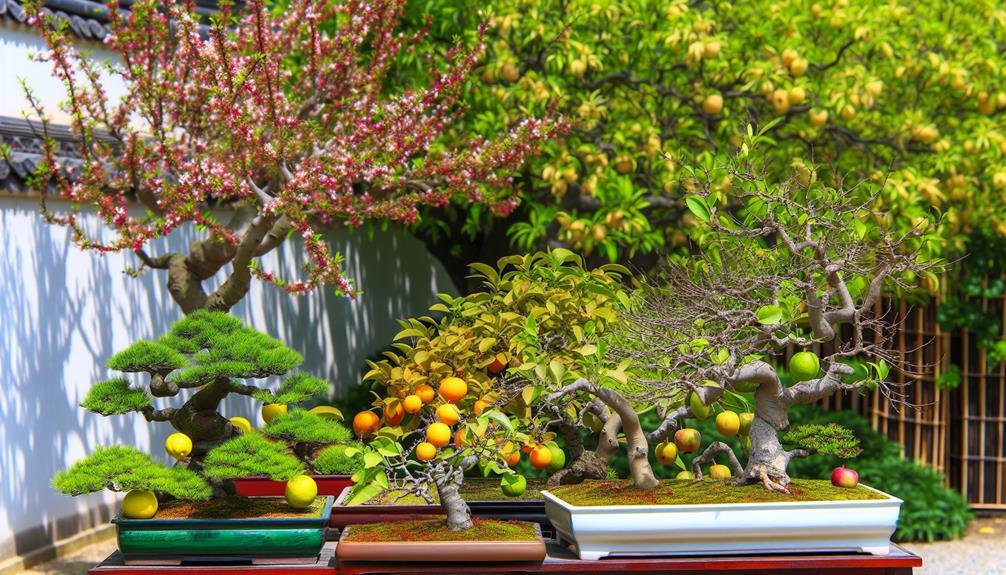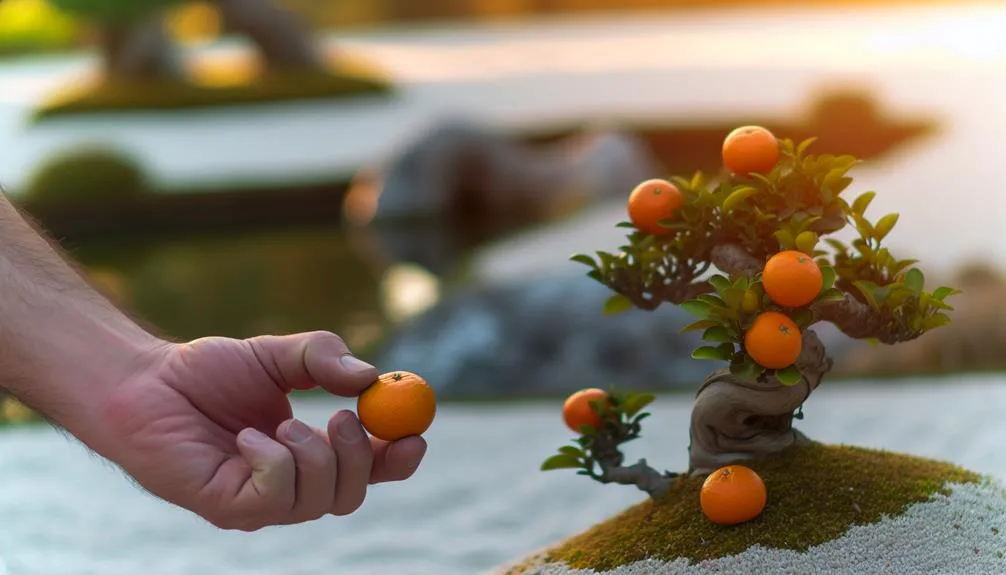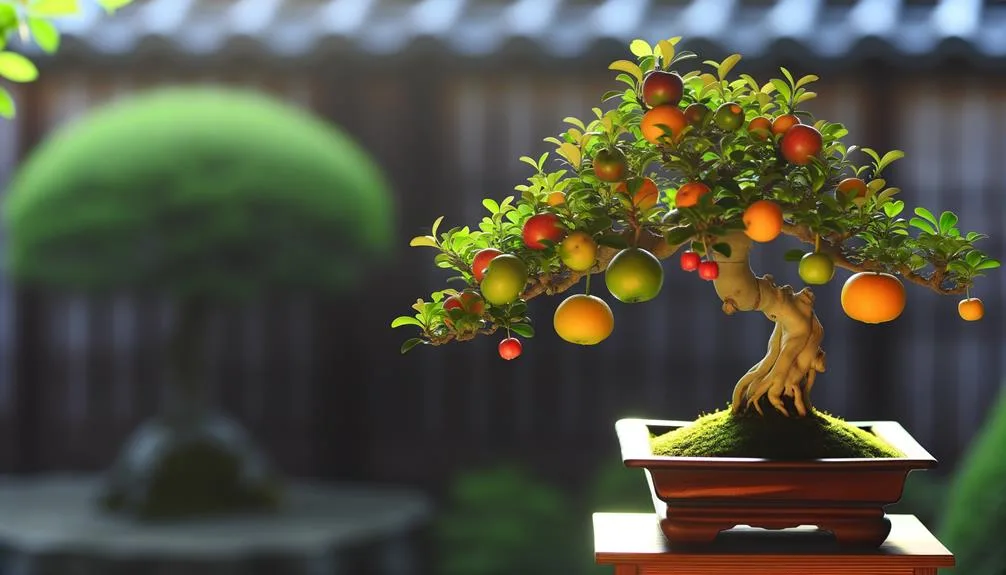Fruit bonsai trees, in my experience, represent a form of artistry and patience that becomes even more complex and rewarding than when cultivating non-fruit-bearing miniature trees. This endeavor requires a nuanced understanding of not only the bonsai technique in general but also the specific attributes of different fruit-bearing species like a cherry bonsai or an orange bonsai.
What captures my fascination about fruit-bearing bonsai trees, such as the cherry and orange bonsai, is the delightful incongruity of seeing full-sized fruits on these miniature trees. This surprising phenomenon, especially when a miniature tree like the cherry bonsai produces full-sized cherries, combined with the Bonsai aesthetics of the trees themselves, makes fruit-bearing bonsai a fascinating topic to explore.
As I continue my exploration, I am eager to unravel the intricacies involved in nurturing these petite wonders, such as cherry and fig bonsai, their diverse types, and the unique care they demand, I invite you to join me on this intriguing journey of discovery.
Key Takeaways
- Artistry and Patience: Cultivating fruit bonsai trees is an art form that requires patience and a deep understanding of bonsai techniques, especially when nurturing fruit-bearing species like cherry and orange bonsai.
- Fascinating Phenomenon: The sight of full-sized fruits on miniature trees, such as cherries on a cherry bonsai, is a delightful and intriguing aspect of fruit-bearing bonsai trees.
- Complex Care: These trees demand detailed knowledge of pruning, wiring, and repotting techniques, as well as regular maintenance like watering, fertilizing, and ensuring proper sunlight exposure.
- Popular Varieties: Some of the favored types of fruit bonsai trees include crabapple, citrus, olive, pomegranate, blueberry, and cherry bonsai, each with its unique aesthetic and fruiting characteristics.
- Seasonal Awareness: Understanding the seasonal needs of fruit bonsai trees is crucial for their health and productivity, with specific care required during spring, summer, fall, and winter.
- Plant Propagation Techniques: Expanding your bonsai collection can be done through seed propagation, cutting propagation, or air layering, each method offering a different approach to cultivating new trees.
- Harvesting Joy: The ultimate reward of nurturing fruit bonsai trees is the joy of harvesting and enjoying the fruits, a tangible result of your dedication and skill.
Fruit-Bearing Bonsai Trees
Fruit-bearing bonsai trees require a deep understanding of specialized techniques and proper care. Popular varieties such as crabapple, citrus, olive, pomegranate, blueberry, and cherry bonsai fall under this category. These miniatures of nature’s giants, like a cherry bonsai or orange bonsai, are no less demanding than their full-sized counterparts.
Understanding fruit-bearing bonsai trees, like an orange or cherry bonsai, involves mastering specific techniques. Pruning, wiring, and repotting are crucial in maintaining the tree’s size and shape, whether it’s a fig bonsai or a cherry bonsai. Leaf size reduction is also important in ensuring the tree’s aesthetics align with its small stature, especially when the tree doesn’t produce fruits like a flowering bonsai.
Keeping the often large size of fruits, like those on an orange bonsai, in check is another challenge in the world of fruit-bearing bonsai trees. Special care is required to manage this without compromising the health of the tree or the quality of the fruit, especially for delicate trees like the cherry bonsai.
Apart from these techniques, appropriate care is fundamental in cultivating fruit-bearing bonsai trees, whether it’s a fig bonsai or a cherry bonsai. This includes regular watering, fertilizing, and correct placement for optimal sunlight exposure. Regular maintenance and shaping are also necessary for fruitful growth.
Popular Types of Bonsai Fruit Trees
Popular types of Bonsai fruit trees, such as crabapple, citrus, olive, pomegranate, and blueberry emerge as favorites among enthusiasts. The Crabapple Bonsai tree, for instance, is admired for its elegant appearance and abundant, small, vibrant apples.
Citrus bonsai trees, on the other hand, encompass a variety of species, including the much-loved lemon tree. This bonsai brings an exotic, tropical touch to any collection, bearing miniature, tangy fruits. Olive bonsai trees are also favored. Known for their resilience and longevity, they are an emblem of peace and wisdom.
Not to be overlooked, pomegranate bonsai trees are appreciated for their lush, glossy leaves and scarlet, jewel-like fruits. Meanwhile, the blueberry bonsai tree, best grown in containers, enchants with its delicate flowers and bright, juicy berries.
The American persimmon is another popular choice. This bonsai, native to North America, is celebrated for its large, sweet, and flavorful fruits. These trees are a testament to the fact that size isn’t a restriction to bearing fruit, encapsulating the beauty and marvel of fruit-bearing bonsai trees.
The Bonsai Apple Tree
Bonsai apple trees are a delightful addition to any bonsai garden. They offer the best of both worlds with their stunning bonsai aesthetics and the promise of edible fruit. As one of the best bonsai fruit plants, these tiny trees transform the art of bonsai with their ability to flower and fruit, providing a unique spectacle unlike any other.
The apple bonsai, much like its counterparts the pomegranate tree and the persimmon tree, is a popular fruiting bonsai, revered for its beautiful bonsai fruit and the joy of growing fruit trees in miniature form. These trees are known not just for their aesthetic appeal but also for their fruit production, making them a top choice for enthusiasts looking to combine the art of bonsai with the pleasure of harvesting their own best fruit.
Caring for an apple bonsai involves understanding the needs of fruit tree bonsai. These deciduous tree species can be used as a stunning bonsai when given the right conditions. Bonsai soil, a suitable bonsai pot, and a bonsai tool kit are essential for maintaining the health and beauty of these miniature trees.
The tree needs plenty of sunlight and careful watering to thrive. While the apple bonsai is a popular bonsai tree, other fruit tree species like the fig tree, plum tree, and even exotic varieties such as the quince bonsai and star fruit bonsai are also popular in bonsai for their flowering and fruiting capabilities. Each tree species has its own requirements, but generally, these trees need plenty of care and attention to encourage fruit production and maintain their beautiful bonsai form.
Incorporating various bonsai styles, enthusiasts can create a bonsai display that showcases the best bonsai trees, including the apple bonsai. These trees bonsai are not just about the fruit; they are about creating a living art form. The size of the tree, the shape of the tree trunk, and even the color of the fruit all contribute to the overall aesthetic of the bonsai display.
With proper bonsai tree care, these miniature trees can live for many years, providing joy and beauty to any space. Whether you’re a seasoned bonsai artist or a beginner eager to get fruit from your very own tree, the apple bonsai stands out as one of the best fruit trees to cultivate, promising a rewarding and beautiful bonsai experience.
Care and Maintenance Tips
Care and maintenance are essential in cultivating fruit-bearing bonsai trees to ensure their health and fruit production.This includes regular pruning, repotting, and specific watering and fertilizing techniques. Regular pruning is crucial for growing a bonsai, as it helps maintain the tree’s shape and size. Wiring is also an important technique that aids in achieving the desired form.
Repotting needs to be done every 2-3 years for the proper development of the root system. This is more frequent compared to regular trees but is a necessary step for a healthy indoor bonsai tree. Additionally, applying leaf size reduction techniques is important for a balanced appearance. Although delicate, this process adds to the bonsai’s aesthetic appeal.
Proper sunlight exposure and acidic soil are required for optimal fruit production in fruit-bearing bonsai trees. These conditions are especially crucial for bonsai trees grown in containers. Watering and fertilizing should be done based on the specific needs of the tree. It is important to avoid overwatering or over-fertilizing, as these can be detrimental to the tree’s health. Careful observation of the tree’s responses to these practices is key.
The Art of Bonsai Pruning
Mastering the art of bonsai pruning demands meticulous attention to detail, as it involves precise shaping and trimming to maintain the tree’s miniature stature and desired form. It is a crucial step in the journey to creating a beautiful bonsai.
Regular pruning controls the branches, foliage, and roots growth, fostering a balanced and visually pleasing structure. It’s a key factor in creating a miniature bonsai tree that mimics the grandeur of its full-sized counterpart in nature.
Effective pruning techniques include selective branch removal, tip pruning, and thinning. These methods ensure the overall health and shape of the bonsai tree, contributing to its aesthetic appeal. For a bonsai to truly flourish, one must understand the growth patterns and needs of the specific fruit tree species.
Such knowledge guarantees successful pruning, which in turn, ensures the tree’s capacity to produce and sustain miniature fruits. The art of bonsai pruning, therefore, is a delicate balance of knowledge, technique, and a keen eye for detail. It’s the cornerstone of maintaining the intricate beauty of a fruit-bearing bonsai tree.
Fruit Bonsai Trees and the Changing Seasons

Building upon the knowledge of bonsai pruning, it’s essential to understand the interplay between fruit bonsai trees and the changing seasons. Seasonal changes impact the growth and fruit production of these miniaturized trees, including popular varieties like the Japonica Bonsai.
In spring, the fruit trees awaken from dormancy, and new growth emerges. This is the ideal time to prune and shape the tree. Summer is the growing season for most fruit trees, including the Japonica Bonsai. Regular watering and fertilizing during this period ensure robust growth and fruiting.
As fall approaches, fruit-bearing bonsai trees prepare for dormancy. Regular watering should continue, but fertilizing should be reduced. The tree in a small pot requires protection from harsh winter conditions.
Winter is the resting phase for fruit bonsai trees. They require less watering, and no fertilizing is needed.
Understanding these seasonal needs of fruit bonsai trees is vital for mastery. Proper care throughout the seasons ensures that the tree remains healthy and productive, providing the joy of nurturing a tree in a small container to full fruit-bearing potential.
Propagating Your Bonsai Tree
Propagating your bonsai tree is a rewarding endeavor. Expanding your bonsai collection through propagation can be achieved through methods like seed propagation, cutting propagation, or air layering.
Seed propagation involves harvesting seeds from the bonsai, planting them, and providing the right conditions for germination. This method, however, requires patience as it might take up to 21 days for the seeds to sprout.
Cutting propagation, on the other hand, involves taking a small portion of the tree, treating it with a rooting hormone, and allowing it to grow in a suitable environment. This method allows you to control the size of the tree, making it easier to maintain.
The third method, air layering, is a more advanced technique. It involves inducing root growth on a branch while it is still attached to the parent tree. Once the new roots have formed, the branch is cut off and planted separately.
Regardless of the method chosen, propagating your bonsai tree requires careful attention and care. The reward, however, is a new bonsai that you have nurtured from the beginning, a testament to your horticultural skills.
Harvesting and Enjoying Bonsai Fruits

Harvesting and enjoying bonsai fruits from your miniature masterpiece is the next exciting phase after successfully propagating your bonsai tree. This step is a testament to your mastery of the craft, a reward that is both aesthetically pleasing and delightfully tangible.
Here are some poignant moments you will experience:
- The joy of discovering the first budding fruit on your Olive tree bonsai. This moment marks a significant milestone in your bonsai journey.
- The anticipation that builds as you carefully monitor the progress of each fruit, such as the vibrant Chinese quince, from blossom to full maturity.
- The sense of achievement when you finally harvest the ripe fruits. This could be a handful of blueberries or a singular, perfectly formed Winterberry (Ilex).
- The unique pleasure of tasting the fruits of your labor. Each bite is a celebration of your patience, dedication, and skill.
Fruit-bearing bonsai trees, like the citrus varieties or pomegranate, provide an exceptional way to enjoy the art of bonsai. The process of nurturing these trees and harvesting their fruits encapsulates the essence of bonsai – the creation of a full life experience in miniature form.
Frequently Asked Question
What Are the Best Fruit Bearing Bonsai Trees?
Ideal fruit-bearing bonsai trees combine aesthetic appeal with suitable maintenance requirements and climate adaptability.
Crabapple and citrus varieties, for example, offer visual appeal and thrive in full sun.
Olive trees and pomegranates are highly adaptable to different climates and are relatively easy to maintain.
Bonsai maintenance tips include regular pruning, wiring, and repotting.
Regardless of choice, successful bonsai cultivation and care requires careful attention to the tree’s individual needs and environmental conditions.
Can a Bonsai Tree Bear Fruit?
Yes, a bonsai tree can bear fruit. Successful fruit production is dependent on various factors including the bonsai cultivation techniques employed, like pruning and wiring, as well as the type of tree species.
Fruit quality analysis is essential to ensure the produced fruits are healthy. Bonsai propagation methods also play a significant role in fruit-bearing.
Careful attention to these elements can result in a bonsai tree that not only looks attractive but also produces fruit.
What Is the Rarest Bonsai Tree?
In the ancient art of bonsai, the ‘Pseudocydonia sinensis’ or Chinese quince, is the rarest. Its allure lies in the unique small, fragrant fruits it bears, adding a new dimension to bonsai maintenance techniques.
This variety, due to its scarcity, presents a notable challenge even among diverse bonsai tree varieties, making it a prized possession for those seeking mastery in this traditional practice. Its elegance and cultural significance further enhance its desirability among bonsai enthusiasts.
What Happened to the 400 Year Old Bonsai Tree?
The 400-year-old bonsai tree, a testament to tree longevity secrets and a symbol of bonsai’s cultural significance, was unfortunately stolen from a Japanese nursery. This incident sparked concerns about the protection of these valuable trees and highlighted the need for reliable age verification methods.
The bonsai community and authorities are vigorously working together to ensure its safe return, underscoring the importance of preserving these ancient living artworks.




